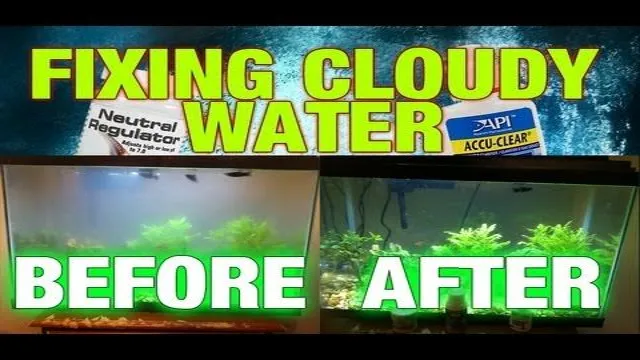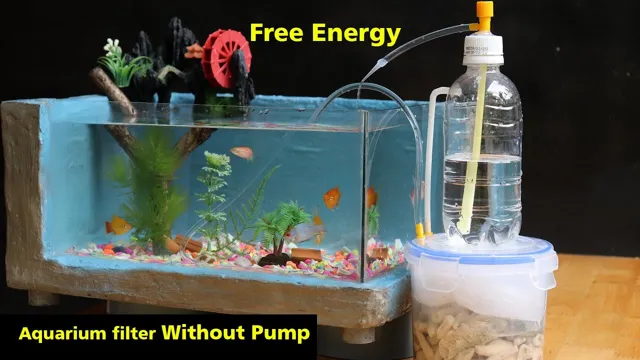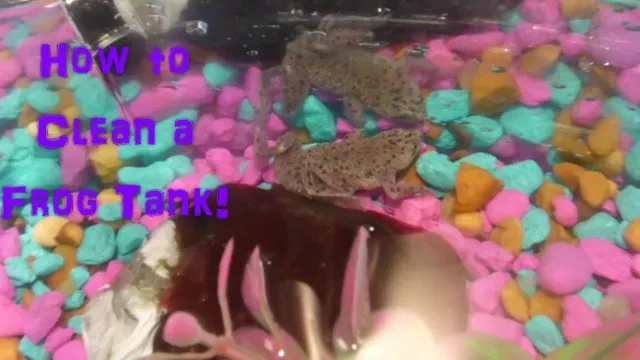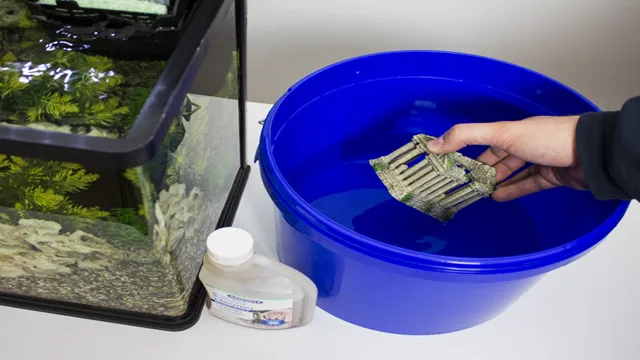Do you find yourself constantly battling cloudy water in your aquarium? It’s frustrating to have a beautiful aquatic environment that you can’t even see! Cloudy water can be caused by numerous factors such as overfeeding, overstocking, and poor filtration. But don’t worry, there are ways to fix this issue and prevent it from happening again in the future. In this blog post, we’ll provide you with tips and tricks on how to clear up cloudy aquarium water, so you can finally enjoy the beauty of your underwater world.
Why is your aquarium water cloudy?
If you’re a fish enthusiast, there’s nothing more frustrating than having cloudy water in your aquarium. The first thing to understand is that cloudy water can have different causes, making it essential to identify the cause before solving the problem. In most cases, excess feeding, a dirty substrate, or overstocking of fish can cause cloudy water.
Other culprits include lack of filtration or improper water flow. To clean the cloudy water, the first step is to perform a 20% to 30% water change and vacuum the substrate. Next, check the filters and clean or replace them as necessary.
It’s also crucial to regulate feeding, ensuring you’re not overfeeding the fish. If the water is still cloudy after these steps, you may need to add water clarifiers or use an ultraviolet light – but be sure to consult with a fish expert before doing so. By regularly monitoring and performing maintenance on your aquarium, you can enjoy crystal-clear water and healthy fish.
Overfeeding your fishes
Overfeeding your fishes can lead to a number of aquarium problems, one of which is cloudy water. When you give your fish more food than they can eat, the uneaten pieces become trapped in the water and begin to decompose. This creates an overabundance of organic matter that can quickly turn into a breeding ground for harmful bacteria.
As these bacteria multiply, they can rob the water of oxygen and create a cloudy, murky appearance. Not only is this unattractive, but it can also be a health hazard for your fish. The best way to prevent cloudy water caused by overfeeding is to only give your fish the amount of food they can eat in a 2-3 minute time span, and to remove any uneaten pieces.
This will keep your aquarium water clear and healthy for your fish to thrive in. Remember, a little bit of food can go a long way when it comes to your fish’s health and the health of your aquarium.

Limited filtration
One of the most common reasons for cloudy aquarium water is a limited filtration system. If your aquarium is not equipped with proper filtration, the water may become murky and unsuitable for the fish and plants living inside. Inadequate filtration can lead to a buildup of waste, uneaten food, and other organic matter that can cause bacterial growth and muddiness in the water.
It’s essential to invest in a high-quality filtration system that can accommodate the size of your aquarium in order to keep the water clear and clean. A clogged or dirty filter can also contribute to cloudy water, so it’s essential to maintain and clean your filtration system regularly. By ensuring that your aquarium has adequate filtration, you can keep your aquatic pets happy and healthy in a clear, sparkling environment.
Too many fishes in a small aquarium
If you’re finding that your once-clear aquarium water has become cloudy, the issue may have to do with overcrowding. Having too many fish in a small aquarium can lead to a buildup of waste, which in turn can cause the water to become cloudy. This occurs because the bacteria in your tank are working to break down the waste produced by your fish.
As the waste levels increase, so does the amount of bacteria, which can ultimately lead to cloudy water. To combat this problem, you may need to consider reducing the number of fish in your tank or upgrading to a larger aquarium. It’s important to remember that fish need space to swim and thrive, and overcrowding can be detrimental to their health.
By creating a healthy living environment for your fish, you’ll not only reduce the risk of cloudy water, but also ensure your fish live long and healthy lives.
How to clean cloudy water: Step-by-step guide
If you notice your aquarium water is cloudy, it’s important to act fast to prevent any harm to your fish and aquatic plants. The first step in cleaning cloudy water is to perform a partial water change. This means removing a portion of the water and replacing it with fresh, clean water.
It’s important to also clean your filter or replace it if needed. Another method to clear up cloudy water is to use a water clarifier or flocculant. These products help to bind together tiny particles in the water, making them easier to remove through filtration.
Remember to not overfeed your fish, as uneaten food can contribute to cloudy water. With a little patience and diligence, you can restore your aquarium to a clear, healthy environment for your aquatic inhabitants to thrive in. (See Also: How to Make a Self Sustaining Saltwater Aquarium: A Step-by-Step Guide)
Step 1: Check and maintain the filters
If you’re wondering how to clean cloudy water in your pool, the first step is to check and maintain the filters. Your pool’s filters play a crucial role in keeping the water clean and clear. Over time, the filters can become clogged with dirt, debris, and other contaminants, leading to cloudy water.
That’s why it’s important to clean and maintain your pool’s filters regularly. Start by turning off the pool pump and removing the filter. Rinse it off with a hose to remove any debris and buildup.
If the filter is very dirty, it may need to be soaked in a filter cleaning solution. Once the filter is clean, reattach it to the pool pump and turn it back on. By keeping your filters clean and well-maintained, you can help ensure that your pool’s water stays crystal clear all season long.
Step 2: Reduce feeding frequency
Reducing feeding frequency is the second step towards clearing cloudy aquarium water. Overfeeding your fish is one of the main causes of cloudy water. The uneaten food and fish waste produce excess organic matter, which then leads to poor water quality and cloudiness.
To avoid this, it’s important to feed your fish only what they can consume within five minutes, and no more than twice a day. In some cases, you might need to cut back on feeding even more. It’s also a good idea to include a variety of foods in their diet.
In addition to commercial foods, you can add fresh or frozen vegetables, live or frozen insects, or even homemade fish food. Remember, reducing feeding frequency doesn’t mean starving your fish. It’s all about providing a healthier and cleaner living environment for them.
By following this step, you will see a visible difference in your aquarium water clarity.
Step 3: Replace a portion of the water
When it comes to cleaning cloudy water, replacing a portion of the water is an essential step that can make a significant difference in the clarity of the water. This process not only helps to remove some of the impurities in the water but also replenishes it with fresh, clean water. To do this, start by draining out a quarter of the water and then replacing it with fresh water.
Repeat the process every two to three days until the water clears up. This step is crucial to maintaining good water quality, especially if you have fish or other aquatic animals living in the water. By doing this, you are ensuring their wellbeing and providing them with a healthy living environment.
So don’t overlook the importance of replacing a portion of the water when cleaning your cloudy water. Your aquatic friends will thank you for it.
Step 4: Use water clarifiers
Water clarifiers can be a great solution for cleaning cloudy water in your aquarium or pond. These products work by grouping together fine particles that make the water cloudy, allowing them to be removed by a filter or by settling at the bottom of the tank. It’s important to use a water clarifier that is designed for your specific water type, as some products may cause harm to certain fish or plants.
Follow the instructions carefully, and remember that this is not a permanent solution to cloudy water – regular maintenance and cleaning is still necessary to keep your aquatic environment healthy. By using a water clarifier, you can quickly improve the clarity of your water and create a more enjoyable environment for your aquatic pets.
Step 5: Monitor the water quality
Monitoring the water quality is a crucial step in cleaning cloudy water. It ensures that the water is safe for consumption and for the aquatic life in your aquarium. First, test the pH level of the water as it affects the survival of your aquatic pets.
Ideal pH levels should be in the range of 8-8 for most species. (See Also: How to Kill Cyanobacteria in Freshwater Aquarium: Effective Tips and Tricks)
Next, test the ammonia and nitrite levels in the water as high levels of these compounds can be toxic to your aquatic pets. Finally, monitor the water temperature as it is also vital for the survival of your aquatic pets. A slight change in temperature can cause stress and even death to some species.
By regularly monitoring these parameters, you can maintain a healthy and thriving aquatic environment for your pets. Remember, the key to keeping your cloudy water clear is by monitoring and testing regularly.
Preventing cloudy water in the aquarium
As a fish keeper, you want to keep your aquarium looking clean and clear, but sometimes, cloudy water can ruin the aesthetics. Cloudiness in aquarium water can be caused by various factors, such as overfeeding, bacterial blooms, and excess nutrients. To prevent cloudy water, it’s crucial to maintain a consistent cleaning routine, ensuring that your filters are working correctly and are cleaned regularly.
Additionally, avoid overfeeding your fish, as uneaten food can cloud the water and contribute to bacterial growth. Adding plants to your aquarium can also help absorb excess nutrients and prevent cloudy water. Finally, perform regular water changes to maintain a healthy water balance, and test the water regularly for accurate parameters.
With regular maintenance and proactive measures, you can prevent cloudy water in your aquarium and keep your fishy friends happy and healthy.
Maintain a cleaning schedule
Maintaining a regular cleaning schedule is essential when it comes to preventing cloudy water in your aquarium. This includes performing regular water changes and cleaning the filter system at least once a month. When left unchecked, excess waste and debris can build up, leading to a rise in ammonia and nitrite levels in the water, which can cause cloudiness and harm the fish.
It’s also important to clean any ornaments, gravel, or live plants in the aquarium to prevent them from becoming breeding grounds for harmful bacteria. By keeping up with a regular cleaning routine, you’ll ensure that your aquarium remains clean and clear, providing a healthy environment for your aquatic friends to thrive in. So, don’t forget to schedule in some regular tank maintenance to keep your fishy companions happy and healthy!
Keep an eye on the feeding frequency
Preventing cloudy water in the aquarium can be a challenge for many fish enthusiasts. One important factor to consider when trying to maintain water clarity is the feeding frequency of your fish. Overfeeding your fish can cause excess food to remain in the tank, breaking down and releasing nutrients that encourage algae growth and cloudiness in the water.
Keep an eye on how much food you are giving your fish and make sure it is being eaten within a few minutes. If you notice any uneaten food, use a siphon to remove it from the tank. It is better to feed your fish multiple small meals throughout the day rather than one large meal, as this will help ensure that all the food is consumed promptly.
By being mindful of your fish’s feeding habits, you can help maintain a clean and clear environment for them to thrive in.
Avoid overstocking
Overstocking your aquarium is a surefire way to cloudy water and other problems, such as stress and disease among fish. To prevent this, it’s crucial to avoid adding too many fish or plants to your tank, which can cause a spike in ammonia and other harmful chemicals. A good rule of thumb is to have no more than one inch of fish per gallon of water.
In other words, if you have a 20-gallon tank, you should have no more than 20 inches of fish in total. Additionally, be mindful of the type of fish you are adding and their behavior. Certain species require more space or have aggressive tendencies that can harm other fish in a cramped environment.
By avoiding overstocking, you’ll not only maintain healthy water conditions but also create a comfortable and safe environment for your aquatic pets. (See Also: How to Make Your Own Aquarium Soil: A Step-by-Step Guide for Pet Lovers at PetsPetsTheNest)
Check the water chemistry
When it comes to preventing cloudy water in your aquarium, one of the most important steps is to check the water chemistry. This includes monitoring the levels of ammonia, nitrites, nitrates, pH, and water hardness. These parameters can fluctuate over time, and if not properly maintained, can lead to the growth of harmful bacteria and algae that can cloud the water.
Regular testing and adjustments to the water chemistry can help prevent these issues and maintain a healthy environment for your fish. Think of it like maintaining a balanced diet for yourself, if the chemistry in the water is off, it’s like eating an unhealthy meal that can lead to a host of problems. So be sure to test your water frequently to ensure it stays crystal clear and your fish can thrive.
Conclusion
In conclusion, cleaning cloudy water in your aquarium is a delicate balance of science, patience, and a little bit of elbow grease. Just like any other problem in life, you don’t want to jump to drastic measures and upset the delicate ecosystem you’ve created. Taking the time to assess the situation, adjusting your filtration system, and performing regular water changes will go a long way in keeping your aquarium water clear and your fish happy.
And if all else fails, remember the wise words of my grandpa: “when in doubt, just add more plants.” Happy cleaning!”
FAQs
What causes cloudy water in an aquarium?
Cloudy water in an aquarium can be caused by several factors such as overfeeding, high levels of waste and debris, inadequate filtration, and bacterial blooms.
How can I improve the filtration in my aquarium to prevent cloudy water?
You can improve the filtration in your aquarium by using a high-quality filter, cleaning it regularly, adding filter media like activated carbon or bio-filtration balls, and ensuring that it is properly sized for your aquarium.
What are some natural ways to clear up cloudy water in an aquarium?
Natural ways to treat cloudy water include water changes, adding live plants to the aquarium, using a UV sterilizer, and adding beneficial bacteria to the water.
Can I use chemical treatments to clear up the cloudy water in my aquarium?
Yes, you can use chemical treatments like water clarifiers to clear the cloudy water in your aquarium. However, it is important to follow the instructions carefully and only use products specifically designed for aquarium use.
How often should I change the water in my aquarium to prevent cloudy water?
It is recommended to change 10-25% of the water in your aquarium every 1-2 weeks to prevent cloudy water and maintain the health of your fish.
Can overcrowding cause cloudy water in an aquarium?
Yes, overcrowding can lead to high levels of waste and debris in the water, which can cause the water to become cloudy. It is important to ensure that your aquarium is properly sized for the number of fish you have.
Is there anything else I can do to prevent cloudy water in my aquarium?
Yes, you can prevent cloudy water in your aquarium by avoiding overfeeding, maintaining proper water chemistry and temperature, cleaning the aquarium regularly, and using high-quality fish food and supplements.







